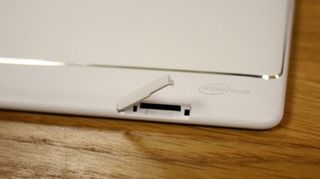TechRadar Verdict
The Asus ZenPad S 8.0 packs great specs and well-rounded features into an attractive tablet that won't break the bank, and which competes strongly with more expensive competitors.
Pros
- +
Low price
- +
Superb high-res screen
- +
Stereo speakers
Cons
- -
A lot of pre-installed apps
- -
Flimsy microSD socket cover
- -
Average camera
Why you can trust TechRadar
Asus brought one of the first Android Honeycomb 3.0 tablets to the market in 2011 in the form of the EeePad Transformer, and has been plugging away at the tablet scene ever since in an effort to create the fabled 'iPad killer' so many Android-lovers are looking for.
While the company has continued to impress, with some serious improvements in its Transformer line of tablets, few tablets other than the Google-branded original Nexus 7 have managed to sell in significant numbers.
Asus has the Apple iPad Mini 4 firmly in its sights with its latest attempt, the ZenPad S 8.0, which carries a low price tag of £169.99 ($199 or AU$279) – that's almost half the price of the cheapest 7.9-inch tablet from Apple.

Compared with the Asus MeMO Pad 7, which we reviewed earlier this year, the ZenPad S 8.0 has a higher-resolution 2048 x 1536 IPS screen, which with 324ppi is both incredibly sharp and has iPad-rivalling viewing angles and colour. As with the MemoPad Asus is sticking with the quad-core, 64-bit Intel Atom Z3560 running at 1.83 gigahertz, coupled with 2GB of RAM.
There are plenty of other extras worth mentioning, such as the dual front-facing speakers with Dolby DTS-HD technology, and 32GB of storage space that can be increased by a further 128GB via a microSD card slot.
The ZenPad S 8.0 is also one of the first tablets to include a USB Type-C connector rather than micro USB, which enables faster transfers and quicker charging, and is reversible, like Apple's lightening connector.
Design
The ZenPad S 8.0 measures just 203.2 x 134.5 mm and is light enough to comfortably hold in one hand; at just 6.6mm thick it feels super-thin and well balanced. The 76.5% screen-to-body ratio is far from the worst you'll find, and is enough to give most videos the full-screen cinematic treatment.

Up front the design offers little to distinguish it from the tablet pack beyond the dual front-facing speakers. A chrome bezel separates the third-generation Gorilla Glass from the plastic chassis, while on the rear a second chrome bezel splits the soft plastic from a leather-effect portion that affords a little extra grip (depending how you hold it).
On the right edge you'll find a nondescript volume bar and power/wake button, which while far from stylish are at least raised enough to make them easy to blindly locate. There's a 3.5mm headphone jack on the top left, and the USB-C socket and a microphone on the bottom.
The left edge is home to the microSD card slot, which is hidden under a little flap. Although the cover does sit flush with the casing and protects the slot from dust, it's not exactly the sturdiest example of its type , and it feels like it could be rather easily snapped off.

As for cameras, there's a rear-facing 8MP unit and a 5MP front-facing shooter for selfies and video calling. Neither is accompanied by a flash, although if you're serious about taking a high-quality snap it's unlikely that you'll be resorting to a tablet to do so.
Interface and features
While the Nexus 7 may have been a totally stock Android experience, Asus has since moved onto its own ZenUI launcher, which in this case is based on Android Lollipop 5.0. While other launchers do nothing to improve the Android interface ZenUI does very little harm, and in some cases is an improvement.
For starters, the skin is highly customisable, and is a little more intelligent than Google's stock experience when it comes to things such as sorting newly installed apps. After installation, ZenUI will automatically sort an app into a number of pre-made 'Smart' folders, or in some cases will make a new folder, as was the case when I installed a couple of games.

Asus has been careful not to drastically overhaul some of the best parts of Android, simply putting its own spin on well-rounded existing features such as the pull-down notifications and quick-settings pane, and the multi-tasking apps menu.
The lock screen serves up useful information such as the weather, location and any notifications you might have pending, as well as quick access to apps such as the camera, email and web browser, all of which can be launched with a quick tap and a swipe.
It's a handy feature that's found in many third-party launchers, but like the rest, it quickly disappears into the background if you turn on the PIN or pattern lock screen security options.

With abundant customisations through ZenUI, it's no surprise that even the app drawer has had every conceivable option thrown in for good measure. You can change the grid size, lock and hide apps, and much more besides.
In fact, you can tweak ZenUI to look exactly as you wish (although none of these extras get in the way of usability). You can leave the ZenPad S 8.0 exactly as it comes out of the box if you prefer, but those who like to adjust background transparency, icons, icon label colours and default system fonts will find these options, and lots more, in the app drawer's preferences menu.

